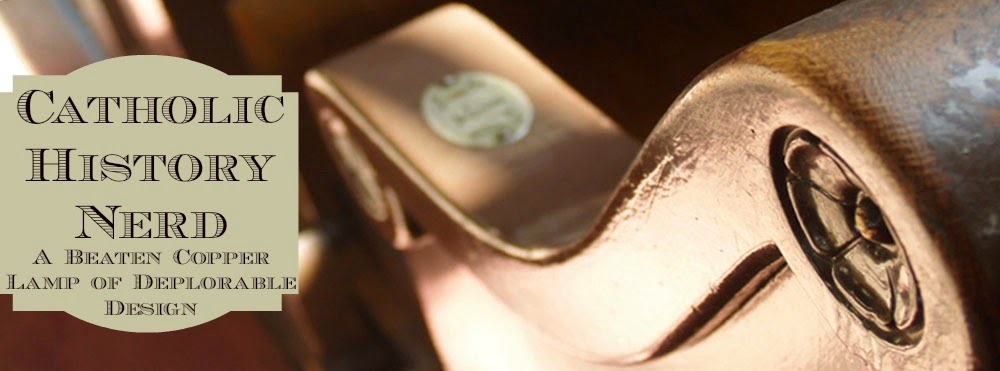| Fr. Junipero Serra in Statuary Hall Image via Architect of the Capitol |
Today is the feast of Blessed Junipero Serra, the 18th century Spanish Franciscan priest who
established the California missions. Fr. Serra will have another big day this
fall, when Pope Francis canonizes him while visiting Washington, DC. This honor
has sparked new interest in his story, including some
protests decrying the negative medical and social effects missionaries had
on native peoples. The story of Serra's missionary work is indeed complicated, as he both imposed harsh physical discipline but also advocated for native people against abuse by Spanish soldiers. Even if his evangelization techniques were heavy-handed, it’s undeniable that Serra
began the legacy of Hispanic peoples in California that continues to this
day.
Despite all this
publicity, a memorial of Serra is now at risk. California’s legislature is considering a motion to remove Fr. Serra's statue in the US Capitol and replace it with one of astronaut Sally
Ride. While the first woman in space deserves recognition too, the statue swap
proposal comes at an unfortunate time, particularly since Serra's canonization
will coincide with the first trip to America by a Latino pope, and the first
time a pope will address Congress.
The Serra statue
situation is not unlike the recent news about Alexander Hamilton’s place on the
ten dollar bill. Hamilton is enjoying a surge
of recognition too, as the star of a smash hit musical opening on Broadway
later this month. Thanks to new biographers, he’s moving out of the obscure
historical shadows. As the first Secretary of the Treasury and architect of the
US financial system, his face on money seems like an obvious choice. But now he
is being removed to make room for the first female figure on American paper
currency.
Debates over Serra and
Hamilton’s small monuments make it seem like gender recognition in history is a
zero-sum game. If we honor significant women, particularly modern ones, that
means we must demote the contributions of past centuries’ “great men”. I argue
that there is room for both. Sally Ride and Harriet Tubman need not compete
with Serra and Hamilton. The real rival here is the over-publicized presidency.
Both men are being obscured because Americans like to go with the obvious and
recognize presidents over and over again.
Take Serra’s spot in the National Statuary Hall Collection, for example. The collection was established in
1864 as a way to use to the vacant space of the old House of Representatives
chamber. Each state could submit two statues of notable citizens. The early
1880s - 1920s roster consisted of Revolutionary War figures, settlers, Civil
War soldiers, and now obscure 19th century politicians, plus the odd inventor
or two. As the ranks have grown, statue displays have spread throughout the
Capitol complex. When I worked the US Capitol Visitors Center, the different
figures provided a fun scavenger hunt and conversation starter with visitors.
Since 2003, states may swap out existing statues for new honorees. Subjects must be deceased, and states
are responsible for funding and commissioning new artwork. One reason for this
new rule was to help diversify and update the collection a bit, swapping out
the 19th century politicians no one remembered anymore.
Unfortunately, many states that have changed their statues have gone with the obvious option of,
you guessed it, presidents. Dwight D. Eisenhower of Kansas and Gerald Ford of Michigan have joined Statuary Hall. California made a
similar switch in 2009, swapping Unitarian abolitionist Thomas Starr King for President Ronald Reagan. That left Fr. Serra's 1931 statue as the only potentially free California
spot. So instead of Ride joining Serra to complete California’s exploratory
legacy, Statuary Hall will become more like the greatest hits of the 1980s.
Similarly, Alexander Hamilton is on the chopping block because the Treasury is too attached to
President Andrew Jackson. A recent grassroots movement called to replace Jackson’s
image on the twenty dollar bill with a notable historical women. There was even
a poll that selected Harriet Tubman. Instead, the Treasury has decided that
women are only worth half that, and offered us a bureaucratic accountant
instead of a controversial chief executive.
It’s troubling that our national memory can trend toward simply the most famous, the most powerful. This
implies that we’re only smart enough to read history as an “icons” roundup in
People Magazine. One of my favorite confused tourist stories was the time I overheard a woman explaining the World War II Memorial while walking down the National Mall. She pointed to the group of columns symbolizing the sacrifices of soldiers from every state and said "Look! That's where all the presidents are buried!" Facepalm.
In my opinion, the Statuary Hall collection is best as a federal pantheon of "lay" citizens and the legislators who served them. The Capitol represents the legislative branch and is meant to be the "house of the people," not a shrine to unilateral power. Likewise, our money isn’t exclusively for presidents. Hundred dollar “Benjamins” celebrate an inventor, author, and diplomat who never lived in the White House.
In my opinion, the Statuary Hall collection is best as a federal pantheon of "lay" citizens and the legislators who served them. The Capitol represents the legislative branch and is meant to be the "house of the people," not a shrine to unilateral power. Likewise, our money isn’t exclusively for presidents. Hundred dollar “Benjamins” celebrate an inventor, author, and diplomat who never lived in the White House.
Later this week we’ll
celebrate America’s independence, a feat that was the work of many people. It would not have happened without the George Washingtons and Thomas
Jeffersons, but neither would the Revolution have made it without the
lesser-known men and women who supported their ideas and did the hard, daily
work of fighting for freedom. We don’t have a king on our money, and there is
room for all of us in America’s story.





